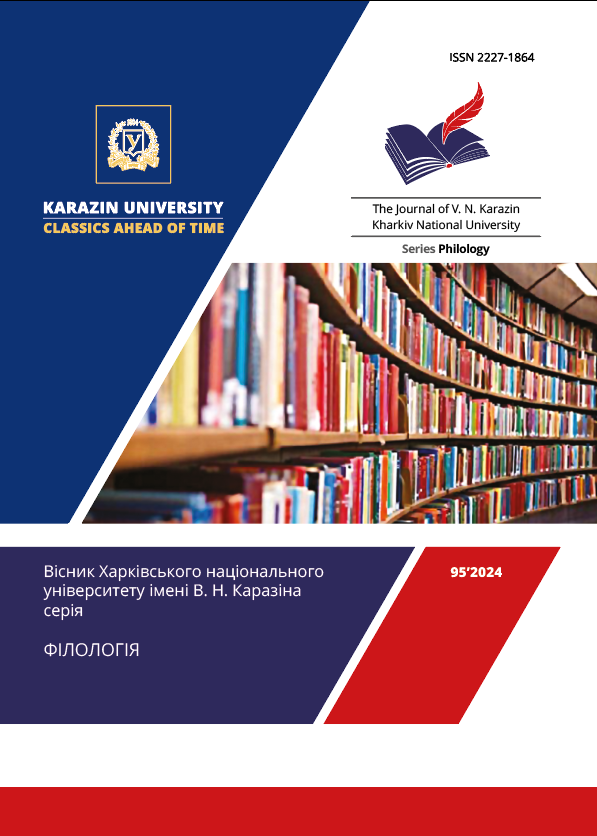Футуристичні візії і класичні міфи: Нелінійний час як інструмент реінтерпретації Античних сюжетів у романі Дена Сіммонса «Іліон»
Анотація
Антична міфологія залишається важливим джерелом натхнення для сучасної літератури, де її сюжети й образи використовуються для реінтерпретації універсальних питань людського існування. У контексті постмодерністських і метамодерністських літературних тенденцій, які надають перевагу нелінійності, інтертекстуальності та багатошаровим наративам, міфологія стає інструментом для розгляду таких фундаментальних тем, як час, простір і доля. Твори Дена Сіммонса, зокрема його Троянська дилогія, є актуальними для вивчення через поєднання античних сюжетів з науковою фантастикою та питанням взаємозв’язку минулого, майбутнього і сьогодення.
Мета статті – дослідити трактування перебігу часу в античній міфології через призму постмодерністських і метамодерністських підходів, які трансформують міфологічні концепції часу і простору в романі Дена Сіммонса «Іліон».
У дослідженні використано порівняльний аналіз античних джерел та творів Сіммонса. Застосовано міждисциплінарний підхід, що включає елементи філософського дослідження міфосвіту в романі «Іліон» із врахуванням культурних, історичних і соціальних аспектів.
Ден Сіммонс у своїх романах створює унікальний хронотоп, де минуле, теперішнє і майбутнє переплітаються. Троянська війна в його творах відбувається в майбутті під кураторством богів Олімпу, тоді як сучасні люди й персонажі Античності взаємодіють між собою. Ключовою особливістю цих романів є оперування законами часу: нелінійні темпоральні виміри та можливість зміни передбаченого прийдешнього стають центральними темами.
Реінтерпретація класичної міфології в новітній літературі, на прикладі творчості Дена Сіммонса, демонструє сенсоутворюючу роль античних сюжетів у дослідженні складних філософських тем. Сіммонс успішно інтегрує міфологічні елементи в наукову фантастику, дозволяючи дослідити в межах постмодерністського і метамодерністського дискурсів питання часу, простору та людської свободи.
Завантаження
Посилання
Borges, J. L. (b. d.). Los cuatro ciclos. La Cuentoneta. https://www.cuentoneta.ar/story/los-cuatro-ciclos?navigation=author&navigationSlug=jorge-luis-borges
Edmunds L. Approaches to greek myth. Johns Hopkins University Press, 2014. 480 p.
Goff B. Do we have a new song yet? The new wave of women’s novels and the homeric tradition. Humanities. 2022. Vol. 11, no. 2. P. 49. URL: https://doi.org/10.3390/h11020049 (date of access: 09.11.2024).
Goldhill S. Christian invention of time: temporality and the literature of late antiquity. University of Cambridge ESOL Examinations, 2021.
Havrylenko-Rusak, V. (2022). Time-Space Relations in the Concepts of Literary Thinking: a Review of Key Ideas. Journal of Vasyl Stefanyk Precarpathian National University, 9(2), 111–117. https://doi.org/10.15330/jpnu.9.2.111-117
Homer. (2006). Iliad (B. Ten, Trans.). Folio.
Iliuchenko, M. (2023). The concept of time in american literature through the lens of metamodern perception. Contemporary literary studies, (20), 91–94. https://doi.org/10.32589/2411-3883.20.2023.293580
Kirk G. S. Greek mythology: some new perspectives. Journal of hellenic studies. 2013. Vol. 92. P. 74–85.
Kozovyk, I. Ya., & Ponomariv, O. D. (1985). Dictionary of ancient mythology. http://litopys.org.ua/slovmith/slovm02.htm
Lehmann-Haupt, C. (1993, 29 kvitnia). Books of The Times; Putting In a Word for Homer, Herodotus, Plato, Etc. The New York Times. https://www.nytimes.com/1993/04/29/books/books-of-the-times-putting-in-a-word-for-homer-herodotus-plato-etc.html
Lysak, N. S. (2012). National self-images in irish and ukranian prose of the 1990s. Magisterium: Literature studies, (48), 85–93.
López-Ruiz C. Gods, heroes, and monsters: a sourcebook of greek, roman, and near eastern myths in translation. Oxford University Press, 2018. 622 p.
Monica, R. (2009). Encyclopedia of greek and roman mythology. Facts On File, Inc.
Oleinykova, H., & Kolehaieva, I. (2009). Tіme’s shіft as a method of alіenatіonіn scіence fіctіon. Writings in Romance-Germanic Philology, (24), 111–121.
Pagès J. The mythographus homericus. The oxford handbook of greek and roman mythography. 2022. P. 211–C16.P120. URL: https://doi.org/10.1093/oxfordhb/9780190648312.013.17 (date of access: 09.11.2024).
Simmons, D. (2005). Ilium. HarperTorch.
Simmons, D. (2006). Olympos. Harper Voyager.
Zhdanov, V. I. (2008). Introduction to the Theory of Relativity. Kyivskyi universytet. https://www.mao.kiev.ua/biblio/mono/Vstup_do_teorii_vidnosnosti.pdf




